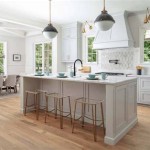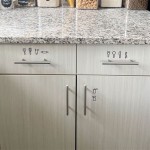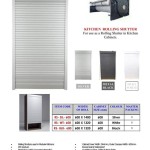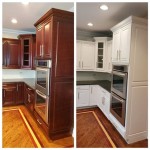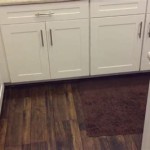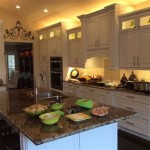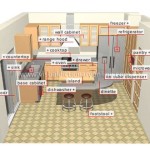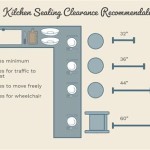Best Polyurethane Sheen For Kitchen Cabinets
Selecting the appropriate polyurethane sheen for kitchen cabinets is a crucial decision that significantly impacts the overall aesthetic and functional longevity of the cabinets. Polyurethane acts as a protective barrier against moisture, scratches, and daily wear and tear, making it a popular choice for sealing and finishing wood surfaces in high-use areas like kitchens. The sheen level, referring to the amount of light reflected from the finished surface, determines the cabinets' appearance and influences their cleanability and perceived durability.
Different sheen levels, ranging from matte to high gloss, offer distinct visual characteristics and performance attributes. A careful consideration of these factors is necessary to ensure the chosen polyurethane sheen aligns with the desired kitchen style, lighting conditions, and maintenance preferences. The goal is to select a polyurethane that not only enhances the cabinets' beauty but also provides optimal protection in a demanding environment.
Before selecting polyurethane, cabinets must be properly prepared. This typically involves cleaning and sanding the surface to create a smooth, even base for adhesion. Depending on the condition of the wood, primer or stain may also be applied before the polyurethane coats. The type of wood used for the cabinets also impacts the sheen appearance. Some woods, like maple, tend to reflect light differently than woods like oak.
Understanding Different Polyurethane Sheen Levels
Polyurethane sheens are classified based on their reflective properties, influencing how much light bounces off the surface. The spectrum ranges from matte, which offers the lowest reflectivity, to high gloss, representing the highest reflectivity. Each sheen level presents unique aesthetic and functional advantages. The appropriate sheen level depends on several factors, including the desired look, the kitchen's natural and artificial lighting, and the level of maintenance required.
Matte Polyurethane: Matte polyurethane has a very low gloss level, typically reflecting less than 10% of light. This finish creates a soft, non-reflective appearance that minimizes imperfections and scratches. Matte finishes are often preferred for creating a rustic, understated look or disguising existing damage on older cabinets. However, matte surfaces can be more challenging to clean than higher gloss options because they tend to trap dirt and grime more easily. They also may not offer the same level of durability as higher gloss options, potentially requiring more frequent reapplication.
Satin Polyurethane: Satin polyurethane offers a balance between matte and semi-gloss, exhibiting a subtle sheen that reflects approximately 20-30% of light. Satin finishes provide a smooth, velvety appearance that is more forgiving of imperfections than higher gloss options. Its mid-range sheen level makes it relatively easy to clean and maintain, offering good resistance to scratches and stains. Satin is a popular choice for kitchen cabinets as it provides an elegant look without being overly reflective. It works well in a variety of kitchen styles, from traditional to contemporary.
Semi-Gloss Polyurethane: Semi-gloss polyurethane reflects around 40-50% of light, offering a noticeable sheen that brightens the kitchen and enhances the cabinets' color. This sheen level is known for its durability and ease of cleaning. The reflective surface makes it easier to wipe away dirt, grease, and food splatters. Semi-gloss is often a preferred choice for kitchens where cleanliness and durability are primary concerns. The high reflectivity can accentuate imperfections, so careful surface preparation before application is crucial. It is easier to spot flaws in the surface with this sheen level. Semi-gloss is often used in kitchens looking for a bright, modern, and clean aesthetic.
Gloss Polyurethane: Gloss polyurethane has the highest reflectivity, typically reflecting 60% or more of light. This finish provides a shiny, mirror-like appearance that can dramatically brighten a kitchen and highlight the cabinets' details. Gloss finishes are extremely durable and easy to clean, offering excellent resistance to scratches, stains, and moisture. However, gloss finishes also tend to accentuate imperfections and require meticulous surface preparation to achieve a flawless look. Gloss can be used to provide a very contemporary or high-end aesthetic. It is typically used in modern and minimalist settings.
Factors to Consider When Choosing Polyurethane Sheen
Several factors influence the choice of polyurethane sheen for kitchen cabinets. These include the kitchen's style, the amount of natural and artificial light, the desired level of maintenance, and the presence of imperfections on the cabinet surfaces. Evaluating these factors helps homeowners and professionals make informed decisions that align with their specific needs and preferences.
Kitchen Style and Design: The overall style and design of the kitchen play a significant role in determining the ideal polyurethane sheen. For traditional or rustic kitchens, matte or satin finishes are often preferred for their understated and natural look. These sheens complement the warm tones and natural textures of wood, creating a cozy and inviting atmosphere. In contrast, modern or contemporary kitchens often benefit from the sleek, reflective qualities of semi-gloss or gloss finishes. These high-sheen options enhance the clean lines and minimalist aesthetics, creating a bright and sophisticated space.
Lighting Conditions: The amount of natural and artificial light in the kitchen can significantly impact how the polyurethane sheen appears. In well-lit kitchens, higher gloss sheens can amplify the brightness and create a vibrant, energetic atmosphere. However, excessive light can also accentuate imperfections on the cabinet surfaces, making lower sheen options more suitable. In kitchens with limited natural light, lighter sheens like satin or semi-gloss can help brighten the space without overwhelming it. Choosing a sheen that complements the existing lighting conditions ensures a balanced and aesthetically pleasing result.
Maintenance Requirements: Different polyurethane sheens have varying maintenance requirements. Higher gloss finishes like semi-gloss and gloss are generally easier to clean because their smooth, non-porous surfaces resist dirt and stains. Matte finishes, on the other hand, tend to trap dirt and require more frequent cleaning. The level of maintenance required depends on the homeowner's lifestyle and willingness to dedicate time to cleaning. If ease of maintenance is a priority, higher gloss options are a practical choice. If a more natural look is desired, matte or satin finishes can be used with the understanding that they may require more diligent cleaning.
Imperfections and Surface Condition: The condition of the cabinet surfaces can influence the choice of polyurethane sheen. Higher gloss finishes tend to highlight imperfections like scratches, dents, and uneven surfaces. If the cabinets have existing damage or are not perfectly smooth, lower sheen options like matte or satin are more forgiving. These sheens help to disguise imperfections and create a more uniform appearance. Proper surface preparation, including sanding and filling any imperfections, is essential regardless of the chosen sheen. However, if achieving a perfectly smooth surface is challenging, opting for a lower sheen can minimize the visibility of flaws.
Application Techniques and Considerations
The application of polyurethane is as important as the sheen selection. Proper techniques ensure a smooth, even finish that maximizes the protective qualities of the coating. Certain tools and processes are best suited to different sheens, contributing to the overall quality and appearance of the finished cabinets.
Surface Preparation: Thorough surface preparation is paramount for achieving a professional-looking polyurethane finish. This involves cleaning the cabinets to remove dirt, grease, and any existing coatings. Sanding the surfaces ensures a smooth base for the polyurethane to adhere to. Depending on the wood type and condition, applying a primer or stain may be necessary before the polyurethane coats. Proper preparation minimizes imperfections and ensures the polyurethane adheres properly, resulting in a durable and aesthetically pleasing finish. If the wood grain is particularly open, a grain filler may be necessary to achieve a smooth, even surface. This is especially important when applying higher gloss sheens, as any imperfections will be more noticeable.
Application Methods: Polyurethane can be applied using various methods, including brushes, rollers, and sprayers. Brushes are ideal for small areas and detailed work, providing good control and precision. Rollers are suitable for larger surfaces, offering a faster and more uniform application. Sprayers provide the most even and consistent finish, especially for higher gloss sheens. The choice of application method depends on the homeowner's skill level, the size of the project, and the desired finish quality. Regardless of the method, applying thin, even coats prevents drips, runs, and unevenness. Multiple thin coats are preferable to a single thick coat, as they dry more evenly and provide better durability.
Number of Coats: The number of polyurethane coats affects the durability and appearance of the finish. Typically, two to three coats are recommended for kitchen cabinets. Each coat should be allowed to dry completely before applying the next. Lightly sanding between coats helps to smooth out any imperfections and improve adhesion. The final coat provides the desired sheen level and protects the underlying layers. Applying additional coats can enhance the durability and water resistance, especially in high-use areas like kitchens. However, excessive coats can lead to a thick, unnatural-looking finish. Finding a balance between protection and aesthetics is key.
Drying Time and Curing: Proper drying and curing are crucial for achieving a durable and long-lasting polyurethane finish. Each coat should be allowed to dry completely according to the manufacturer's instructions, typically ranging from several hours to overnight. After the final coat, the cabinets should be allowed to cure for several days to allow the polyurethane to fully harden and achieve its maximum durability. Avoid using or cleaning the cabinets during the curing period to prevent damage to the finish. Adequate ventilation during drying and curing is essential for removing fumes and ensuring proper hardening. Temperature and humidity can also affect the drying time, so following the manufacturer's recommendations is crucial for achieving the best results.

Satin Vs Semi Gloss Kitchen Cabinets Which Is Better

Polyurethane Kitchens

Choosing A Finish For Your Kitchen Cabinets Harrington Kitchens

Painting Cabinets Your Questions Answered Honey Built Home

Matte Vs Semi High Gloss Kitchen Cabinets Pros And Cons

The Best Trim Paint Brand And Type High Gloss Semi Or Satin Designed

Best Finishes For Kitchen Cabinets Cabinet Doors N More

How To Choose The Right Finish For New Kitchen Cabinets Houzz

How To Choose The Best Kitchen Cabinet Finish

Explaining Our Beautiful Kitchen Cabinet Materials Montgomery Homes

